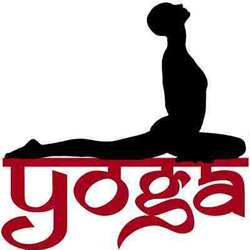Sanskrit Challenge #2 – Yoga Pose Names
 As we move ahead in our Sanskrit Challenge, one of the aims is to demystify Sanskrit and in particular the names of the yoga poses in their original language. While it may seem daunting and obscure, the Sanskrit language is actually very mathematical and precise. With a little memorization and interest, one can easily gain a grasp of the names of the yoga poses in Sanskrit. It is a process that builds on itself step-by-step.
As we move ahead in our Sanskrit Challenge, one of the aims is to demystify Sanskrit and in particular the names of the yoga poses in their original language. While it may seem daunting and obscure, the Sanskrit language is actually very mathematical and precise. With a little memorization and interest, one can easily gain a grasp of the names of the yoga poses in Sanskrit. It is a process that builds on itself step-by-step.
For instance, take one of the more well-known poses: Downward Facing Dog. The Sanskrit name is Adomukhasvanasana. Quite daunting. But see: Ado = Downward, Mukha = Face, Svan = Dog, Asana = Posture. Every portion of the name has a meaning. And then those prefixes, roots, and suffixes get applied to forming the names of other postures.
The term asana (defined in our initial post) is the suffix applied to every yoga posture as named in Sanskrit. So that makes things easy right way – you will always know the ending. Now let’s get in touch with other aspects of Adomukhasvanasana, or Ado + Mukha + Svan + Asana. Let’s look at its antithesis, Upward Facing Dog. That is Urdhvamukhasvanasana. So all we are doing is changing ado (downward) for urdhva (upward). Now you perfectly know two poses.
Well what about Upward Arm Pose, i.e. Urdhvahastasana. Urdhva = upward, hasta = arm, and asaana = posture. So the new term we got is hasta (arm or hand). That brings us to padahastasana, or hand and foot pose. Pada means foot, hasta means arm. and asana – well you know that already.
So as you can see there is a rhyme and reason to it. Just a little memorization is needed to build your base and then in the course of things you will easily be able to decipher and name more and more poses in Sanskrit. There are lots of resources out there such as yoga flash cards, or plain-old vocabulary lists etc. Here is one such vocabulary list for yoga poses I made for last year’s Sanskrit workshop.
The next query that comes to mind is how are our yoga poses named. Well, there are a few basic approaches.
How Are Asanas Named?
1. Based on an anatomical or biological position; (janushiirasana (janu = knee, shiira = head, etc)
2. Based on what the posture looks like; (vrksasana (vrksa = tree), trikonasana (tri = three, kon = angle etc)
3. Based on what benefits the posture offers; (mayurasana / peacock, padmasana / lotus etc)
4. Named after the yogi / yogini who created the posture; (matsyendrasana (Prince Matsyendranath), natarajasana (Nataraj is another name of Shiva) etc)
So now that we have a basic understanding of how the name of a yoga pose can be broken down, and how poses are named, then that sheds a lot of light onto the matter. With a little effort and practice, one can quickly progress.
We close out today’s post with a few interesting aspects of the Sanskrit language.
1. All the vowels come at the very beginning of the alphabet.
2. The first letter of the Sanskrit alphabet is “a”, just as with every other language.
3. There are 50 characters in total in the Sanskrit alphabet.
4. The spelling of Sanskrit using the Roman/ Sanskrit alphabet is: Sam’skrta.
Stay tuned for #3 of the Sanskrit Challenge – coming soon!!
